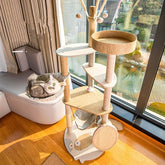Understanding Cat Nail Care: Does Trimming Hurt Them?
Table of Contents
- Key Highlights:
- Introduction
- The Anatomy of a Cat’s Claw
- Why Trim Your Cat’s Nails?
- How to Trim Your Cat’s Nails
- FAQ: Frequently Asked Questions About Cat Nail Trimming
Key Highlights:
- Proper nail trimming, when done accurately, does not hurt cats, just like trimming human nails.
- Key benefits of regular trimming include preventing injuries, protecting furniture, and reducing the risk of ingrown nails.
- Nail trimming requires specific techniques and tools, making it important for cat owners to be informed on best practices.
Introduction
Cats, known for their playful antics and affectionate nature, have a set of claws that play a vital role in their daily activities. From scratching and climbing to grooming, these retractable claws are essential to their behavior and health. However, a common concern among cat owners revolves around nail trimming – particularly, does it hurt? Understanding how to care for feline claws not only ensures your cat's comfort but also keeps your home safe from accidental scratches and damage. This article delves into the anatomy of a cat's claw, the reasons for regular nail maintenance, the techniques involved in trimming, and answers to frequently asked questions about cat nail care.
The Anatomy of a Cat’s Claw
To better comprehend the nail trimming process, it is crucial to understand the anatomy of a cat's claw. Unlike human nails, a cat's claws are retractable, meaning they can be pulled back into a sheath of skin. The claw is primarily composed of keratin, similar to human hair and nails.
The visible portion of a cat’s claw consists of two main parts:
- The Hook: This sharp, curved tip is essential for scratching surfaces, climbing, and self-defense.
- The Quick: Located closer to the paw, the quick contains living tissue, blood vessels, and nerve endings. In cats with light-colored claws, it appears as a pink triangular area, while it is less visible in cats with darker claws.
The primary goal during nail trimming is to avoid cutting into the quick, which can lead to pain and bleeding.
Why Trim Your Cat’s Nails?
Regular nail trimming is an essential component of feline care for several reasons:
- Protects Furniture: Long claws can lead to significant damage to couches, carpets, and other household items. Trimming reduces the risk of unnecessary scratching.
- Prevents Injury to Humans: Cats can unintentionally scratch their owners during play or handling. Keeping their nails trimmed minimizes the potential for painful scratches.
- Avoids Ingrown Nails: Overgrown nails may curl back into the paw pad, leading to pain and infection, especially in older cats or those with limited mobility.
- Reduces Claw Damage: Overextended claws can get caught on furniture or carpeting, resulting in painful breaks or tears.
Caring for a cat’s nails is not just about maintenance; it’s about ensuring their health and comfort.
How to Trim Your Cat’s Nails
While nail trimming may seem daunting for many cat owners, it doesn’t have to be a stressful experience. With the right approach, you can make it a routine part of your cat's care.
Gathering Your Supplies
Before beginning the nail trimming process, ensure you have all necessary supplies handy:
- Cat Nail Clippers: Invest in clippers specifically designed for feline nails. The two main types are scissor-style and guillotine-style. Choose one that you feel comfortable using.
- Styptic Powder: This is essential in case you accidentally cut the quick, as it will help stop any bleeding.
- Treats: Offer rewards to associate nail trimming with positive experiences.
- Towel (Optional): Wrapping your cat in a towel can help calm them and keep them still during the trimming process.
The Trimming Process
Follow these steps for an effective and safe nail trimming session:
- Find a Comfortable Position: Position your cat on your lap or another stable surface where they feel secure.
- Extend the Claw: Gently press on the top of the paw and the underside of the paw pad to extend the claw.
- Identify the Quick: In light-colored claws, the quick is visibly pink, while it may not be as clear in dark claws.
- Trim the Tip: With your chosen clippers, carefully trim only the very tip of the claw, ensuring that you leave a safe distance between the cut and the quick. Aim to cut straight across rather than at an angle.
- Reward Your Cat: After trimming a few nails, immediately offer your cat a treat and praise. This establishes a positive association with the process.
- Repeat: Proceed with trimming several nails at a time. If your cat shows signs of distress, take a break and try again later.
- Dealing with Dark Claws: For dark claws where the quick is difficult to see, trim very small increments. Watch for a chalky ring near the tip, which indicates proximity to the quick.
FAQ: Frequently Asked Questions About Cat Nail Trimming
FAQ 1: What happens if I accidentally cut the quick?
If you cut the quick by accident, your cat may yelp or pull away, and the claw will likely bleed. The important thing is to remain calm. Apply styptic powder to the area; this will quickly stop the bleeding. If you don't have styptic powder on hand, common kitchen items like cornstarch or flour can serve as temporary alternatives.
FAQ 2: How often should I trim my cat’s nails?
The need for trimming can depend on your cat's lifestyle and habits. Generally, indoor cats require trimming every 2-3 weeks, while outdoor cats may need less frequent trimming due to wear from their natural scratching behavior.
FAQ 3: My cat hates having its nails trimmed. What can I do?
If your cat is resistant, patience and positive reinforcement are essential. Gradually introduce your cat to having its paws handled by gently massaging them daily. Allow them to inspect the clippers, pairing this exposure with treats. Start with trimming just one or two nails at a time and gradually increase as your cat becomes more accustomed.
FAQ 4: What are the different types of cat nail clippers?
There are primarily two types of nail clippers available: scissor-style and guillotine-style. Scissor-style clippers closely resemble small scissors and are generally easier to control. Guillotine-style clippers involve inserting the claw into a hole, where a blade cuts through the nail. While some find guillotine-style clippers faster, they may be more challenging to use safely, especially with cats that have dark claws.
FAQ 5: Is declawing a good alternative to nail trimming?
Declawing, which involves surgical removal of the last bone in each toe, is not recommended except as a last resort in cases of severe medical issues. It can lead to chronic pain, behavioral problems, and other adverse health effects. Organizations such as the American Animal Hospital Association (AAHA) and the American Association of Feline Practitioners (AAFP) advocate against declawing, promoting humane alternatives like regular trimming and providing scratching posts.
FAQ 6: How can I tell if my cat’s nails are too long?
If your cat’s nails are frequently snagging on carpets or you hear them clicking on hard floors, they are likely too long. Additionally, if you observe the nails beginning to curl back towards the paw pad, it's time for a trim.
FAQ 7: Can I use human nail clippers on my cat?
No, using human nail clippers on a cat is not advisable. They are designed for flat nails and can crush or split a cat’s curved claws. Always use clippers specifically designed for feline nails.
FAQ 8: What are scratching posts, and how do they help?
Scratching posts are crucial for satisfying a cat's natural need to scratch. They provide a designated area for scratching, encouraging healthy claw maintenance and preventing damage to furniture. When selecting a scratching post, ensure it is sturdy and tall enough for your cat to fully stretch out while scratching. Different materials, such as sisal rope, cardboard, or carpet, may appeal to different cats.
FAQ 9: Can a veterinarian trim my cat’s nails if I’m uncomfortable doing it myself?
Yes, most veterinarians and veterinary technicians are experienced in trimming cat nails and are happy to assist. If you're uneasy about doing it yourself, consider scheduling an appointment for a professional trim. This is also an excellent opportunity to learn proper trimming techniques for future sessions.
FAQ 10: What if my cat is aggressive or bites when I try to trim their nails?
If your cat shows aggression or attempts to bite, stop the trimming session immediately. Forcing the issue can increase fear and resistance in future attempts. Consult with your veterinarian or a certified cat behaviorist to explore desensitization techniques and handling strategies. In some cases, medication or sedation might be necessary to ensure a safe and stress-free trimming experience.
In conclusion, maintaining your cat's claws is a rewarding and essential part of responsible pet ownership. By educating yourself on the anatomy of your cat's claws, the benefits of regular trimming, and the best techniques to use, you can ensure that the process is beneficial for both you and your feline friend. With patience and care, nail trimming can become a straightforward and confident part of your cat's grooming routine.





